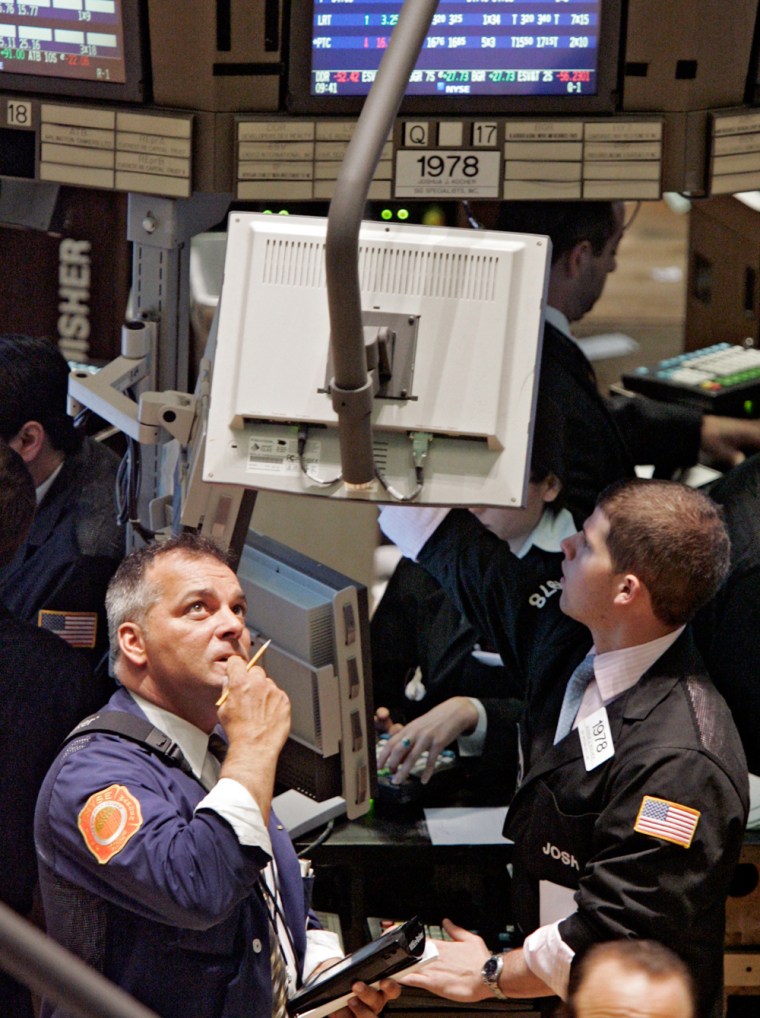The stock market soared to fresh six-year highs Friday as investors welcomed mixed economic news, seeing it as a sign that the Federal Reserve is likely to stop raising interest rates after one more increase next week.
But analysts cautioned that traders might have overreacted to the government's monthly employment report and could be disappointed Wednesday if the central bank fails to give a clear indication of its future plans.
The Dow Jones industrial average closed up almost 140 points, or about 1.2 percent, at 11,578, its highest close since its all-time closing high of about 11,723 on Jan. 14, 2000.
Other broad indexes also were sharply higher after a decidedly mixed employment report, the government's first indication of how the economy performed last month. The economy added only 138,000 jobs last month, which was significantly fewer than the 200,000 many economists had expected. The Labor Department also downwardly revised employment figures for March and April.
But hourly wages were up nearly 4 percent over year-ago levels, the fastest growth rate in nearly five years and a potential inflation signal likely that could prove worrisome to the Federal Reserve, which next week holds its second meeting of policy-makers since Chairman Ben Bernanke took the helm Feb. 1.
"I really do think that the market has bought the story that the weak employment numbers suggest the economy is going to cool off fast enough that the Fed does not have to raise rates" after Wednesday's move, which is considered a virtual certainty, said John Silvia, chief economist at Wachovia Securities.
Art Hogan, chief market analyst at Jefferies & Co., said traders viewed the employment report as falling into the "Goldilocks range," showing an economy growing at just the right speed to allow the Fed to step aside. But he cautioned that stocks and bonds could be set up for a fall Wednesday, because the Fed's policy statement likely will leave at least some ambiguity about its next move.
Bernanke clearly is wrestling with how to communicate with financial markets in a way that upholds his commitment to transparency in the central bank's operations yet leaves him and his colleagues the flexibility to respond to emerging data on the state of the economy.
Bernanke told the Joint Economic Committee last week that the Fed could take a pause at one of its upcoming meetings after a campaign in which it has raised short-term rates 15 straight times dating to June 2004. But in what some observers have described as a rookie mistake, he then told CNBC reporter Maria Bartiromo at a weekend banquet that financial markets had misinterpreted his remarks.
When she went public with those comments on CNBC, stock prices fell sharply as investors wondered whether the Fed might have to continue raising rates longer than expected.
In truth, economists are divided over the Fed's future direction. Many analysts expect the central bank to take no action on rates after its two-day meeting June 28-29, but they say the answer depends largely on a raft of economic data to be released between now and then, including the employment report due June 2.
Silvia said he thinks there is still a significant chance that the Fed raises rates again in June. "I'm not anywhere near as complacent as the bond market," he said. "I think the rally is overdone."
Hugh Johnson, chairman of Johnson Illington Advisors, agreed, saying the employment report was "about as ambiguous as Fedspeak ordinarily is."
"I think there is a little bit of exuberance here, and while I wouldn't call it entirely irrational — be careful," he said.
In general, analysts said the sluggish employment growth was puzzling, coming after a series of reports generally showing a robust economy. Gross domestic product grew at a rapid 4.8 percent rate in the first quarter, and the stock market has rallied this year in part on the strength of good corporate earnings.
The Dow is up about 8 percent so far this year. The broader Standard & Poor's 500 is up 6 percent for the year but still about 13 percent below its March 2000 record close.
"It is pretty clear to me that the undertone of this is a healthy economy that is just better than people thought — sort of chronically better than people thought," said James Paulsen, chief investment officer at Wells Capital Management.
The solid growth and potential for inflation raise the prospect that the Fed indeed might have to raise its benchmark overnight rate even after next week. The underlying "core" inflation rate is already at 2 percent, considered the upper end of the Fed's tolerance zone, and soaring energy prices could drive that underlying figure higher.
The sharp increase in wages could be a sign of labor market tightness, although analysts explained part of the increase by noting that the economy has been adding higher-paying manufacturing sector jobs while shedding lower-paying retail jobs.
Lynn Reaser, chief economist for Bank of America, said the greatest risk is that the Fed "overshoots" by raising interest rates enough to slow the economy sharply, either accidentally or to prevent an outbreak of energy-driven inflation.
Friday's employment report could be early evidence that the economy is already cooling, Reaser said, but added that it was "premature to reach a definitive conclusion."
"This mixed evidence suggest the Fed is well advised to wait for more information," she said.
